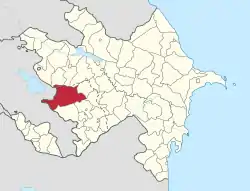Kalbajar
Kalbajar (Azerbaijani: Kəlbəcər ![]() (listen)) is a town and the administrative centre of the Kalbajar District of Azerbaijan.
(listen)) is a town and the administrative centre of the Kalbajar District of Azerbaijan.
Kalbajar
Kəlbəcər | |
|---|---|
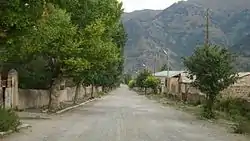 | |
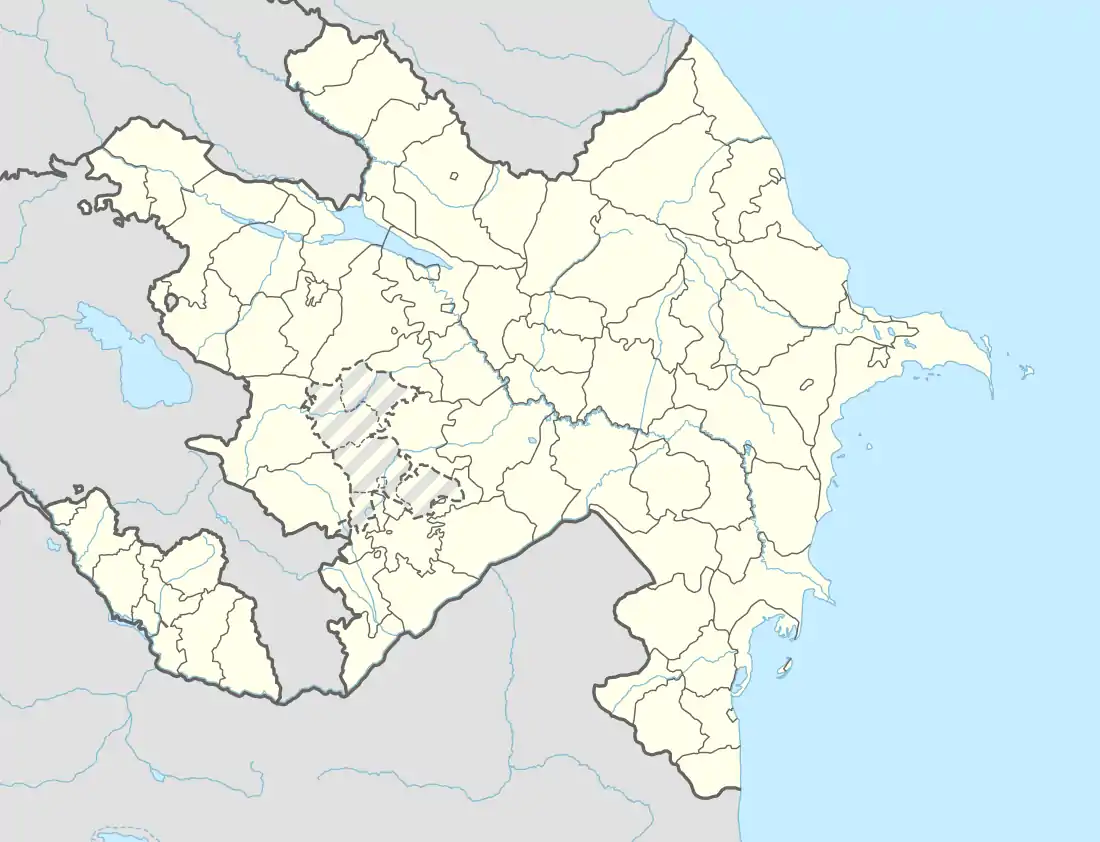 Kalbajar | |
| Coordinates: 40°06′24″N 46°02′18″E | |
| Country | |
| Rayon | Kalbajar |
| Elevation | 1,584 m (5,197 ft) |
| Population (2015) | |
| • Total | 600[1] |
| Time zone | UTC+4 (AZT) |
Etymology
According to the Encyclopedic Dictionary of Place Names of Azerbaijan, there are several theories about the etymology of the town's name. According to one of the versions, the city was originally called Kevlicher, meaning “fortress in the upper reaches of the rivers” (“kevli” - the upper reaches of the river, “cher” / “jar” - fortress) in Old Turkic. According to another version, the name of the town comes from the Persian word "kevil" (cave) and the Turkic word "jer" (rock, ravine) and means "ravine with caves". This etymology is explained by the fact that there are a number of artificial caves along the Tartar River valley, where the town is located. Another version proposes that the name comes from the Turkic words "kevli" (river mouths) and "jar" (gorge, ravine), and that the settlement was originally called Keblajar, but over time the name changed to Kalbajar.[2]
According to Armenian book Dictionary of Toponymy of Armenia and Adjacent Territories, the name Kelbajar is a modified form of Karavachar, a village in the Tsar region (also known as Vaykunik) of the Armenian Principality of Khachen.[3] The village Karavachar is mentioned in the colophon of a 15th century Armenian manuscript. The author writes that he wrote the manuscript in the diocese of the abbot of Dadivank monastery (which still stands today in the modern Kalbajar district), in the village Karavachar of the Tsar region.[4]
History
In 1930, the Kalbajar region with an area of 1936 km² was formed as part of the Azerbaijan SSR, the administrative centre of was the town of Kalbajar, which received the status of a city in 1980.[5]
Battle of Kalbajar
The city was occupied by Armenian forces on 2 April 1993 during the Battle of Kalbajar, near the end of the First Nagorno-Karabakh War and all of its Azerbaijani inhabitants were forced out.[6]
Human Rights Watch findings concluded that during the Kalbajar offensive Armenian forces committed numerous violations of the rules of war, including forcible exodus of civilian population, indiscriminate fire and hostage-taking.[7] In April 1993, the United Nations Security Council adopted Resolution 822 which called for the withdrawal of all occupying forces from the Kalbajar district, including the town of Kalbajar.[8]
Armenian occupation
Following the war, the city and surrounding territory were absorbed into the self-proclaimed Republic of Artsakh becoming the centre of its Shahumyan Province and was renamed Karvachar (Armenian: Քարվաճառ). Starting in the early 2000s, the city was slowly repopulated by Armenian settlers from eastern Shahumyan and Gulustan area which fled during the First Nagorno-Karabakh War.[9] Infrastructure was rebuilt and the town had electricity and a nearby highway connecting it to Armenia. In 2018, the town's school had 177 schoolchildren.[10]
From 2014 to 2020, the city maintained ties with Pico Rivera, California as a friendship city.[11]
Following the end of the 2020 Nagorno-Karabakh War, Armenian armed forces and civilians began to leave the Kalbajar area on 11 November 2020 in preparation for the handover of the town to Azerbaijani control on 15 November 2020. It was reported that some residents were burning their own homes, schools and forests and were cutting fruit trees and downing power lines prior to the handover.[12][13][14] In the days leading up to the return to Azerbaijani control, there was heavy traffic on the road leading into the area as residents rushed to leave while other Armenians rushed to visit the nearby 9th century Dadivank monastery one last time before the border closed.[15]
Return to Azerbaijani control
As part of an agreement that ended the 2020 Nagorno-Karabakh War the town and its surrounding district were initially to be returned to Azerbaijani control by 15 November 2020, but this deadline was subsequently extended to 25 November 2020.[16] The city, along with the district were returned to Azerbaijan on 25 November 2020.[17]
Demographics
| Year | Population | Ethnic groups | Source |
|---|---|---|---|
| 1912 | 300 | 100% Azerbaijani | Caucasian Calendar census[18] |
| 1939 | 1,089 | 88.3% Azerbaijani, 5.1% Russians, 3.9% Armenians | Soviet Census[19] |
| 1970 | 4,775 | 98.4% Azerbaijani, 0.5% Armenian, 0.4% Russian, | Soviet Census[19] |
| 1979 | 5,604 | 99.4% Azerbaijani, 0.1% Armenian, 0.1% Russian | Soviet Census[19] |
| 1989 | 7,246 | Soviet Census[20] | |
| 2015 | 600 | NKR Census[1] | |
Lakes, rivers, mountains and zones
There are 13 lakes in local plains and mountains.
Kalbajar's longest river is the Tartar. Its tributaries are the Tutkhun, Lev, Zaylik, Alolar, and Garaarkhaj (Sarkar) rivers.
There are also 20 well-known water springs.
70-80 per cent of the district is made up of mountains and each of them has a name. Since motor traffic in the mountains is limited, local people have divided the district into different zones:
- 1. Upper zone – territories stretching from the centre westwards
- 2. Ayrim zone – north-west
- 3. Gamishli-Lev zone – north-east
- 4. Tutgu zone – area around Zulfugarli- Baslibel
- 5. Sarsang SES zone – forests in the east
- 6. The Dalidagh-Sariyer-Keyti zone consists of bare mountains and plains
Gallery
 Children playing football (2010)
Children playing football (2010) Street in Kalbajar (2010)
Street in Kalbajar (2010) Street in Kalbajar (2010)
Street in Kalbajar (2010)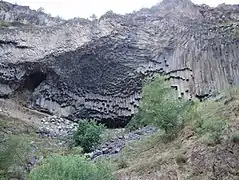 Basalt columns and caves near Kalbajar, locally known as "rock symphony"
Basalt columns and caves near Kalbajar, locally known as "rock symphony" Sunflowers in the countryside
Sunflowers in the countryside Dashtak Gorge on the Tartar River, from Kalbajar
Dashtak Gorge on the Tartar River, from Kalbajar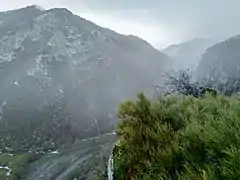 Dashtak Gorge near Kalbajar
Dashtak Gorge near Kalbajar Cultural Center in Kalbajar, under construction
Cultural Center in Kalbajar, under construction
References
- "NKR 2015 Census" (PDF). stat-nkr.am. 2015.
- Aliyeva, R. (2007). Azərbaycan toponimlərinin ensiklopedik lüğəti (in Azerbaijani). Baku: Şərq-Qərb. p. 272. ISBN 978-9952-34-155-3.
- Hakobyan, Tadevos Kh.; Melik-Bakhshyan, Stepan T.; Barseghyan, Hovhannes Kh. (2001). Հայաստանի և հարակից շրջանների տեղանունների բառարան [Dictionary of toponymy of Armenia and adjacent territories] (in Armenian). vol.5. Yerevan: Yerevan State University Publishing House. p. 340.
- Khachikian, L. S. (1955). ԺԵ դարի հայերեն ձեռագրերի հիշատակարաններ, Մասն Ա [The Records of the 15th Century Armenian Manuscripts, Part I (in Armenian). vol.I. Armenian SSR Academy of Sciences Publishing House. p. 24.
և յարհեպիսկոսութեան այսմ նահանգիս տէր Զաքարիայի Դադի Վանուց վերատեսջի, ի հռչակաւոր երկիրս Ծար, ի գևղս Քարավաճառ,...
- "Кельбаджар". Большой энциклопедический словарь.
- "Resolution 822 (1993) adopted by the United Nations' Security Council at its 3205th meeting". UNHCR Refworld. April 30, 1993. Retrieved 22 February 2011.
Noting with alarm the escalation in armed hostilities and, in particular, the latest invasion of the Kelbadjar District of the Republic of Azerbaijan by local Armenian forces
- "Resolution 822 (1993)". undocs.org. United Nations Security Council. 30 April 1993.
- "Resolution 822 (1993)". undocs.org. United Nations Security Council. 30 April 1993.
- The Nagorno-Karabakh Conflict: A Legal Analysis. Heiko Krüger. Springer, 2010. ISBN 3642117872, 9783642117879. p. 102
- Kucera, Joshua (6 August 2018). "For Armenians, they're not occupied territories – they're the homeland". Eurasianet.
- A RESOLUTION OF THE CITY COUNCIL OF THE CITY OF PICO RIVERA, CALIFORNIA, RECOGNIZING THE TOWN OF KARVACHAR, REPUBLIC OF ARTSAKH AS ITS FIRST FRIENDSHIP CITY
- "Nagorno-Karabakh: Villagers burn their homes ahead of peace deal". theguardian.com. The Guardian. 14 November 2020.
- "Nagorno-Karabakh: The families burning down their own homes - BBC News". youtube.com. BBC. 14 November 2020.
- "Kalbajar residents burn homes before Azerbaijan handover". youtube.com. Associated Press. 14 November 2020.
- "Karvachar's Last Day: 'We Stayed Here Until the End,' Artsakh Soldiers Say". Asbarez. 24 November 2020. Retrieved 26 November 2020.
- "Azerbaijan Extends Deadline For Armenia To Withdraw From Key District Under Karabakh Truce". rferl.com. Radio Free Europe. 15 November 2020. Retrieved 2020-11-15.
- "Azerbaijani Forces Reclaim Second District From Armenians Under Nagorno-Karabakh Truce". RFERL.org. Radio Free Europe/Radio Liberty. 25 November 2020. Retrieved 25 November 2020.
- "Caucasian calendar. Tiflis".
- "НАСЕЛЕНИЕ АЗЕРБАЙДЖАНА". ethno-kavkaz.narod.ru (in Russian). Etno Kavkaz.
- "Демоскоп Weekly - Приложение. Справочник статистических показателей". demoscope.ru.
External links
| Wikimedia Commons has media related to Kalbajar. |
- Kalbajar at GEOnet Names Server
- World Gazetteer: Azerbaijan – World-Gazetteer.com
